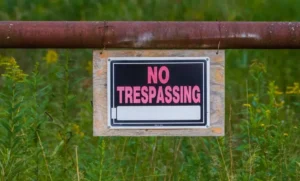Have you ever been walking in a quiet neighborhood or on a trail in the country and noticed a purple fence? Not a regular brown or white fence, but a purple fence like someone dipped it in grape Kool-Aid? Your brain says, okay, why? Is it just an odd choice of color? An odd taste in paint? As it turns out, no. There is a reason. Purple on a fence means one thing: no trespassing.
I know, a little odd. Like, why purple? Why not red, or neon orange, or a literal “keep out” sign? But in many rural areas, purple paint has emerged as a coded signal. In some states, it is even legally recognized. Rather than putting up 25 signs that could blow away or fade, you put a purple mark on a fence post and boom, the message is communicated.

The Rules of the Paint
Now, just because you slapped a little purple on a board, don’t expect everyone to understand. There are rules regarding the paint, depending on where you live. The major one is that the purple marks need to be vertical. Not random dabs of paint, not horizontal graffiti, but vertical stripes. This is how someone knows it is intentional and not just a bored teenager with leftover paint.
Also, size matters. Each stripe should be at least one inch wide and roughly eight inches long—large enough to catch your attention from a fair distance. What’s the point if it’s so small you don’t notice it, or it just looks like a mistake?
Placement matters, too. These marks are required to be painted 3–5 feet off the ground. Any lower and objects like grass or bushes could cover the mark. Any higher and the average person isn’t going to look up while walking by. Three to five feet is the sweet spot.
Plus, it’s not just about a stripe on one fence post. To properly mark your property, the stripes should be spaced about every hundred feet. That way, wherever a possible trespasser might try to enter, they will see a purple mark and (hopefully) take the hint.

Not Every Place Uses It
Here lies the problem – the purple paint laws are not universally accepted. Some states statutorily adopt it, some states are ambivalent, and some might consider it bad form. This is why you should of course check local law regarding purple painting your fence line. Authorities will be state and county, so to foolishly assume one swipe of purple will confer you a property right against trespass, will fall short if not lawful.





